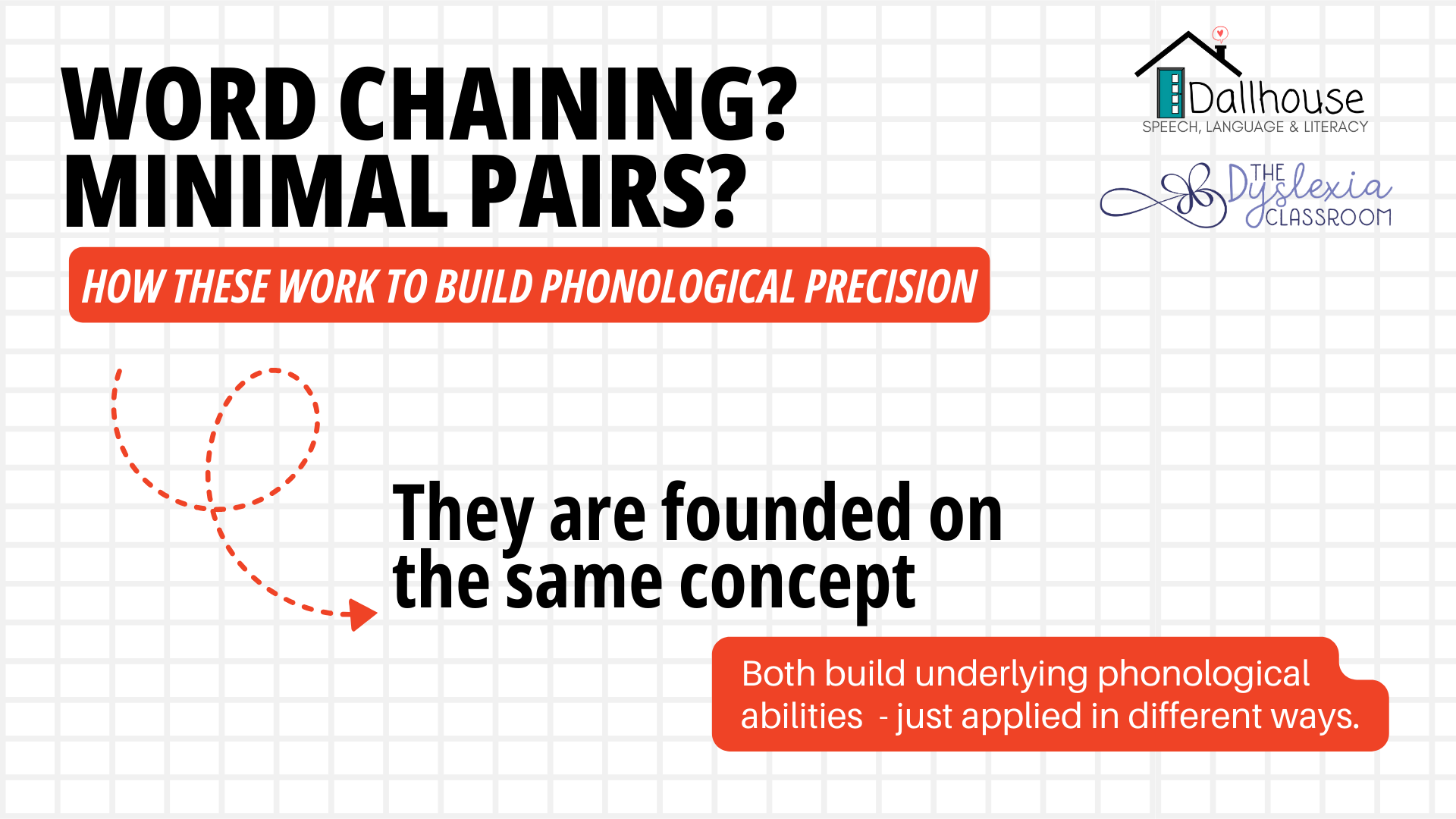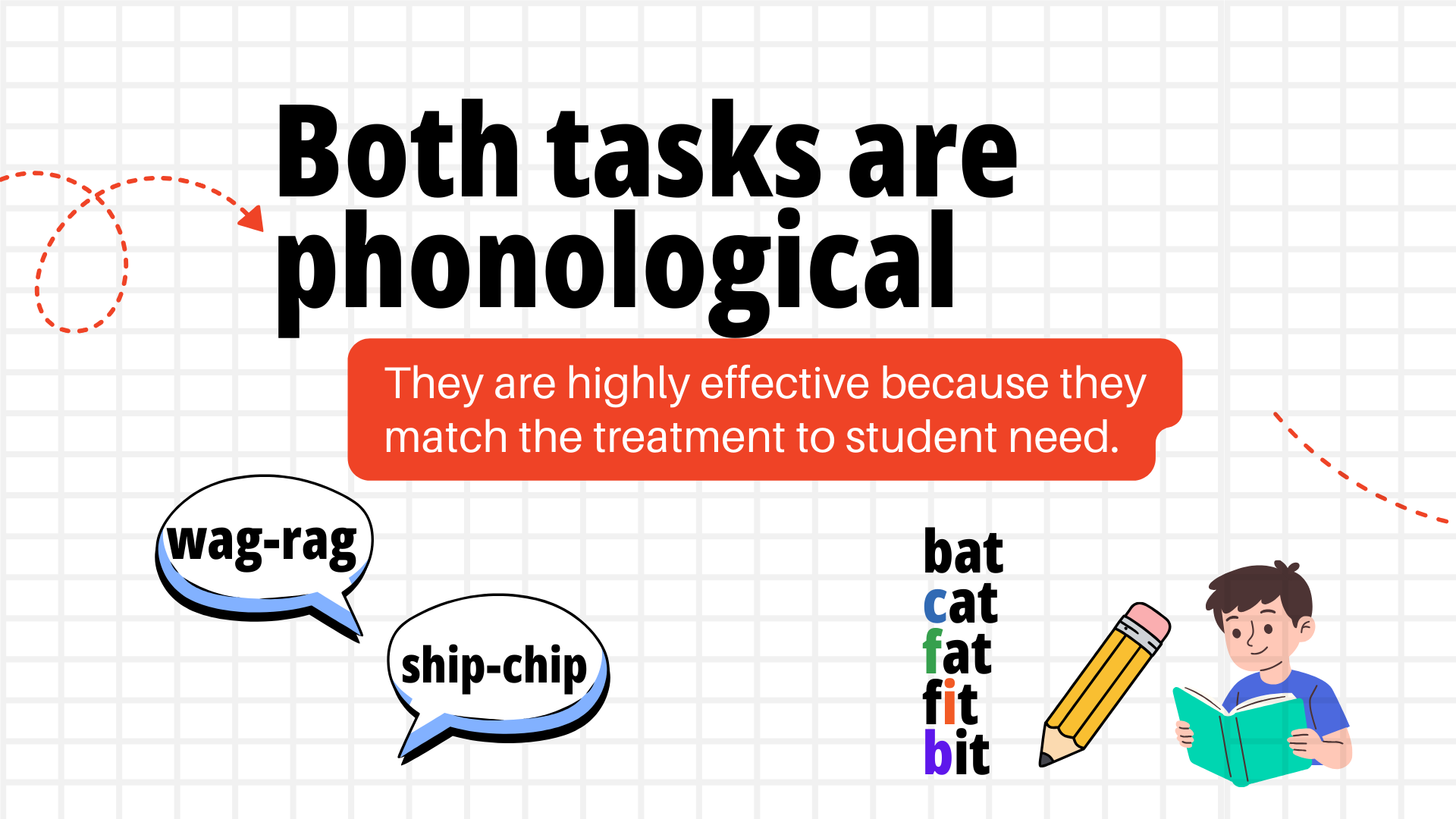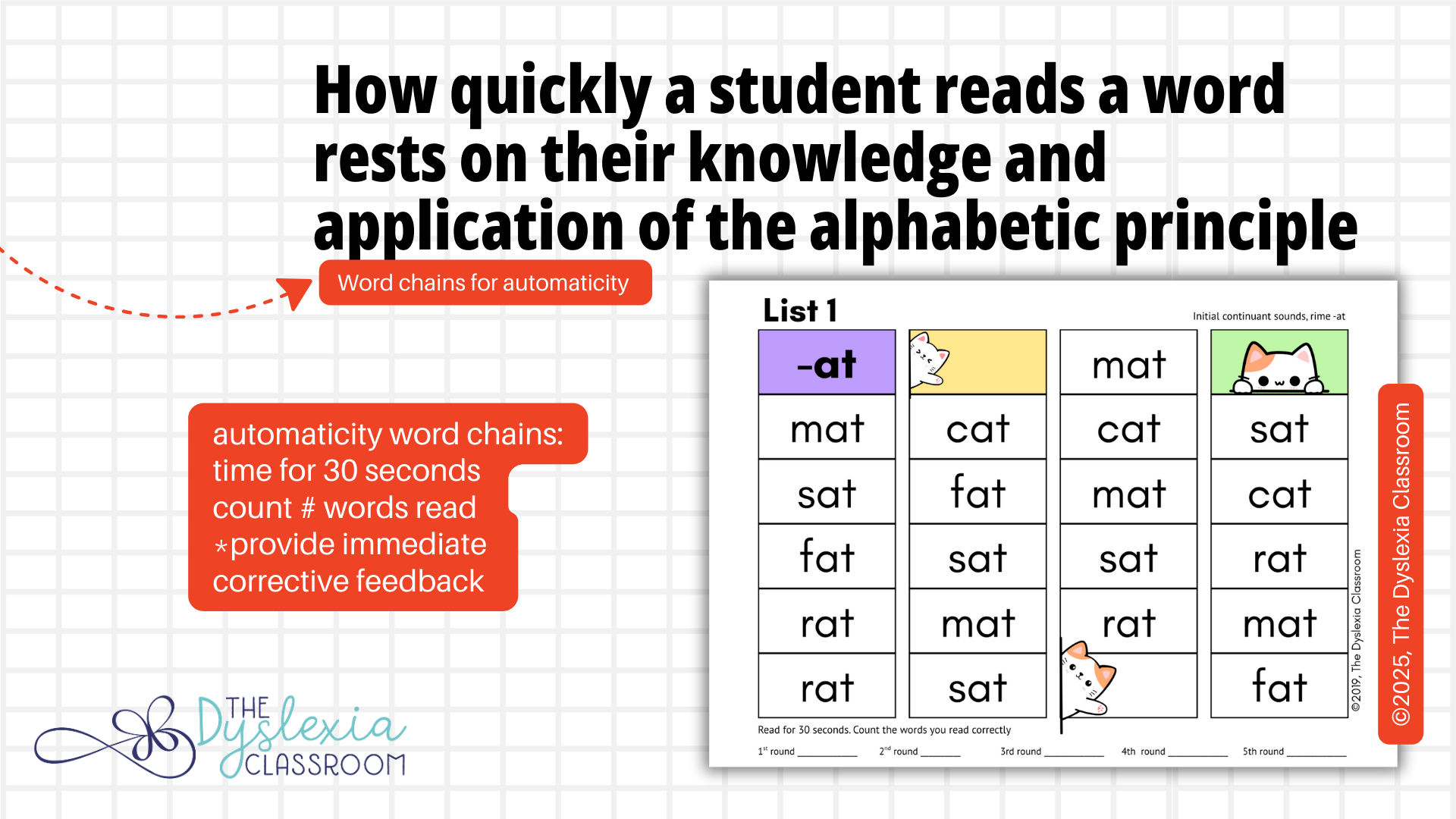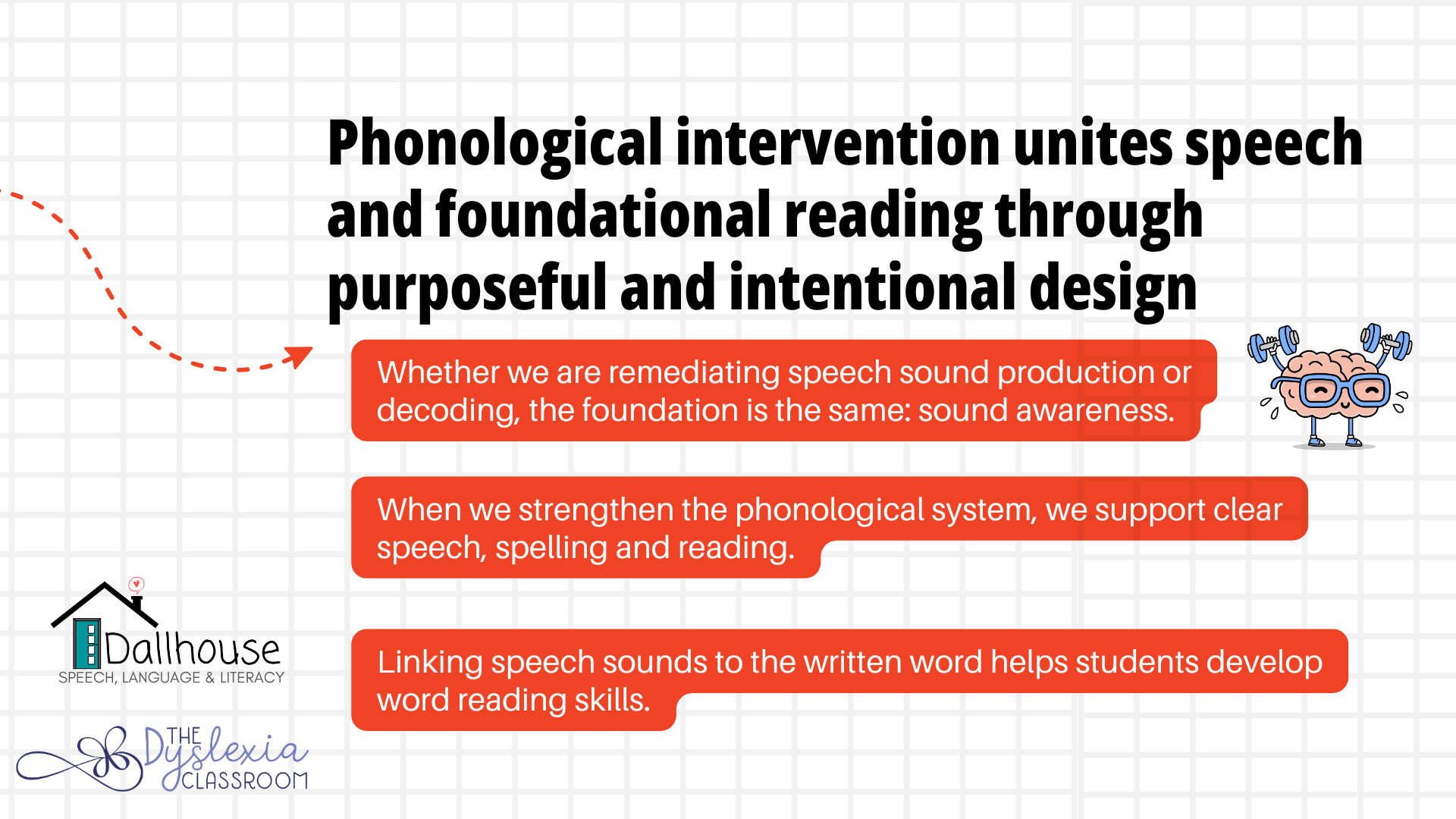From Minimal Pairs to Word Chains: The Speech-Literacy Connection We Can't Ignore
Co-Written by Leanne Dall, MHSc., CCC-SLP, and Casey Harrison, LDT, CSLDS, CALT
*free video link below*
Word chaining has been around for decades, but there's a renewed spotlight on why it's so powerful, especially in the early stages of reading and spelling development. A word chain is essentially a sequence of minimal pairs that we use to improve reading and spelling by focusing on how sounds (phonemes) and letters (graphemes) work together to form words. As we've been reflecting on its impact in light of our newly released CVC Links & Ladders Word Chaining Deck, one truth keeps resurfacing:
Word chaining and minimal pair work share the same phonological roots.

And when we recognize this, our instruction becomes more efficient, more aligned, and more effective.
The Speech–Literacy Link: Why Contrastive Pairs Matter
In speech therapy, SLPs may rely on contrastive phonological approaches, such as minimal and maximal pairs, to spark phonological learning. The minimal pair approach, developed by Dr. Frederick F. Weiner, focuses on words differing by only one sound, or a single phoneme, and by one or two features across the distinctive features of place and manner of articulation or voicing (e.g., pat/bat where the difference lies in /p/ being unvoiced and /b/ voiced).

The maximal pairs approach, developed by Professor Judith Gierut and colleagues, focuses on words differing by only one sound, but across multiple distinctive features of place, manner, and voicing (e.g. sit/bit where the differences between /s/ and /b/ are across the features - /s/ is a fricative, continuous flow of air, unvoiced and /b/ is a stop sound, puff of air, and voiced).
-
Place - where a sound is made (lips, tongue placement)
-
Manner - how the sound is produced (stopping the air, creating friction, allowing air to flow through the nose)
-
Voicing - engaging the voice or not in the sound production
Targeting these contrasting pairs helps children perceive and produce distinct speech sounds in speech therapy. But here's the connection we can't overlook:
These same phonological contrasts are the foundation of reading and spelling.
In the span of human history, written language is relatively new. Reading, while not innate like language, is phonological in nature and requires the child to link the pronunciation of a word, or its sounds, to the orthographic form, the written word, and its meaning. When learning to read or decode, a child must connect spoken sounds to their written representations.
When a child reads sip and ship, they're relying on the exact same skill we strengthen through minimal pair work:
Phoneme-level awareness — the ability to detect, differentiate, and manipulate sounds in words, making the bridge between speech and literacy shockingly clear:
- Oral language is the foundation of written language.
- The links are already there.
- Strengthening one skill strengthens the other.
As SLPs and literacy interventionists, we can become far more efficient when we recognize that speech sound work and decoding/encoding instruction share the same phonological roots.
What Word Chains Are (and Why They're So Effective)
A word chain is a sequence of contrasting word pairs—sometimes minimal, sometimes maximal, and sometimes a combination. Students start with one word and change it into another by adding, removing, or substituting one grapheme at a time.

Example:
pat → mat → map → nap → tap
Every single step requires students to:
- segment (when spelling),
- blend (when reading), and
- manipulate phonemes (switch, add, delete).
Word-chaining taps into a multi-component approach to teaching reading and spelling, providing a more complete approach than reading or segmenting alone. There is substantial evidence that minimal pairs are an effective approach for targeting phonological speech sound disorders. SLPs may start with auditory discrimination between minimal pairs, with the strongest treatment effects emerging when the learner is producing (expressive) the minimal pair, rather than listening (receptive) to it. When we think of literacy learning (or difficulties) as the phonologically-based phenomenon that they are, we can extend these principles from the spoken word to the written word. In addition, incorporating the meaning and language use of the word, along with its pronunciation and written form, strengthens understanding and helps build the child's lexicon. This multi-component nature is what makes word chaining uniquely powerful. It goes beyond reading or segmenting in isolation and taps into the full phonological architecture of literacy.
Reading or Spelling? It Depends on the Instructional Goal
Recently, we have seen many conversations about the best instructional approaches for students with dyslexia or phonological processing disorders, focusing primarily on reading or spelling when using word chains. The instructional focus, whether reading, spelling, or both, when using word chaining, must meet the child's needs and therefore align with the goal. Let's approach this through the diagnostic and prescriptive approach.
If the student presents with labored word reading or retrieval and the goal is to increase automatic word reading…
Using a word chain or blending board, in which only one grapheme is altered before reading the word, provides the student with targeted, controlled practice of previously taught phoneme-grapheme correspondences. Decoding through a chain gives repeated practice in blending and retrieving words.
Example:
Teacher writes cap.
Student reads it.
Teacher changes p → t and student reads cat.
Continue with one sound change at a time.

With the focus on automatic word reading, the teacher controls the pacing of the reading and can speed up student responses while providing immediate corrective feedback when a miscue is made. For example, a teacher can gradually release the need to sound out each word audibly, guiding the student through a progression from subvocalization to internalization before reading aloud. In addition to this release of decoding, the teacher also controls the speed at which the response is made, gradually increasing the pace through a response cue, such as a tap or snap, while the student decodes (audibly, subvocally, or internally) and then responds with the whole word. How quickly a student reads a word rests on their knowledge and application of the alphabetic principle. Creating opportunities for automatic word reading with a word chain provides the teacher and student with in-the-moment data while observing student strengths and needs. A quick way to build automaticity in word reading with word chains is to have the student read a word chain list for 30 seconds. If an error is made, give the word and have the student reread that word. Count up the number of words read and mark the data. Do this multiple times, with the student recording the number of words read and how many were increased.

The use of word chains for reading and spelling provides the student with a smaller target of phoneme-grapheme correspondences to manipulate and read. It can be tailored to include common rime patterns for early readers (seen in the pic) to aid in developing automaticity. Decoding with minimal-pair, maximal, or combined word chains supports the goal of strengthening reading accuracy and automaticity.
If the goal is strengthening spelling...
Explicit instruction that purposefully integrates phoneme awareness, phonics, letter knowledge, and letter formation (handwriting) with deliberate practice and application of the sound-spelling correspondences in decoding and spelling, we establish a bond between speech and print (Harrison, 2025). In other words, spelling engages students in applying the alphabetic principle as they must use their knowledge of sound-symbol correspondences in oral and written output to anchor orthographic representations of words.
Through this, students are applying specific skills such as segmenting, blending, and phoneme manipulation; essentially increasing BOTH reading and spelling outcomes. In addition, spelling allows us to observe the retrieval of letter output for letter formation (with handwriting) or letter recognition (with tiles), as well as the automaticity of retrieval. This integrated approach propels the orthographic mapping process, solidifying the connection between:
- phonemes (sounds)
- graphemes (letters)
- letter names
- letter forms (handwriting)
As noted by Berninger (2012), "Handwriting is producing letters to support writing words, syntax, and text to transform ideas into written language." Embedding transcription skills specific to letter formation (handwriting) within word chaining tasks allows students to engage in translating language to print. When we ask students to write the sounds in a word, we strengthen the orthographic loop and eliminate guessing. If a child can spell a word through phoneme-grapheme linkages, they can almost always read it—but the reverse isn't always true.
This little learner in the video has been using the CVC Links & Ladders with Leanne Dall from Dallhouse Speech and Language to establish strong phoneme-grapheme correspondence while using spelling as the pathway to decoding.
Spelling also requires retrieval practice, which builds linguistic networks, allowing the student to read what they wrote, self-check, and, in addition, provides a window into the underlying linguistic processes, making it easier to see exactly what is going on with the child's language abilities and provide immediate corrections. In our sessions, we incorporate BOTH spelling and reading of word chains for targeted instruction.

Why Focusing on Spelling Within Word Chains Gives Us a Clear Window Into Language
For beginning readers, a strong connection between phonemes and graphemes is necessary for both reading and spelling. Spelling is an expressive task that provides insights into students' knowledge and application of the connection between phonemes and graphemes, essential for reading and spelling.
That means:
- Learners can't guess
- We can observe phonological errors
- We can immediately correct misunderstandings
- We can see retrieval challenges
- We can watch handwriting–phonology connections in real time
Spelling also requires retrieval practice, which builds linguistic networks and strengthens orthographic memory.
In instructional practice:
- encoding (spelling) for building the mapping system
- decoding (reading)for increasing fluency and automaticity
Both have a place—what matters most is that instruction is intentional.

So, Why Combine Speech-Based Contrastive Approaches With Literacy?
Because they are already connected.
Contrastive phonological work (e.g., minimal pairs) and literacy tasks (e.g., decoding and encoding) rely on the same underlying neural and cognitive processes. When we use a contrastive phonological approach in literacy instruction, we're not "borrowing" from speech therapy; we are simply honoring the reality that phonology is the foundation of both speech and written language.
And that means:
- better alignment
- stronger instructional efficiency
- improved reading and spelling outcomes
- less fragmentation across professions
The opportunities with this integrated approach are endless—and it's precisely why we created our word-chaining deck and continue exploring the bridge between speech and literacy.
Want to See Word Chaining in Action?
🎥 Watch the free Links & Ladders video here.
This unique course introduces an innovative approach, using CVC "Links and Ladders," to equip educators, reading specialists, and speech-language pathologists with practical, engaging strategies for building strong foundations in reading and spelling from the very beginning.
Grab this resource! The CVC deck provides a flexible tool for targeting multiple language components—including phonemic awareness, sound-symbol relationships, syntax, morphology, semantics, and speech-sound production.
References:
Harrison, C. (2025). Teaching beyond the diagnosis: Empowering students with dyslexia. Jossey-Bass.
Storkel HL. Minimal, Maximal, or Multiple: Which Contrastive Intervention Approach to Use With Children With Speech Sound Disorders? Lang Speech Hear Serv Sch. 2022 Jul 6;53(3):632-645.



